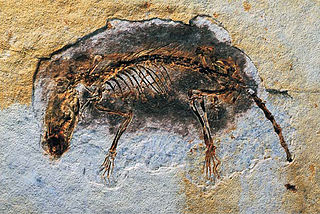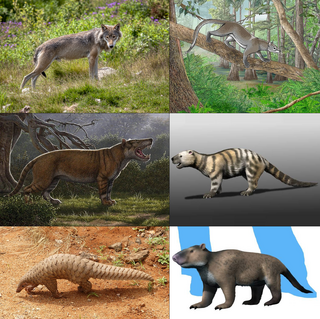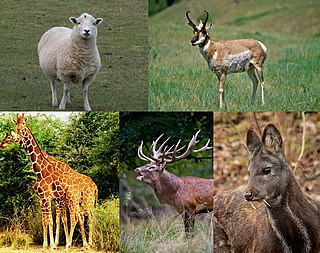
Ungulates are members of the diverse clade Ungulata which primarily consists of large mammals with hooves. Living ungulates are divided into two orders: the odd-toed ungulates (Perissodactyla) including horses, rhinoceroses, and tapirs; and even-toed ungulates (Artiodactyla) such as cattle, pigs, giraffes, camels, sheep, deer, and hippopotamuses. Cetaceans such as whales, dolphins, and porpoises are also classified as even-toed ungulates, although they do not have hooves. Most terrestrial ungulates use the hoofed tips of their toes to support their body weight while standing or moving. Two other orders of ungulates, Notoungulata and Litopterna, both native to South America, became extinct at the end of the Pleistocene, around 12,000 years ago.

The even-toed ungulates are ungulates—hoofed animals—which bear weight equally on two of their five toes: the third and fourth. The other three toes are either present, absent, vestigial, or pointing posteriorly. By contrast, odd-toed ungulates bear weight on an odd number of the five toes. Another difference between the two is that many other even-toed ungulates digest plant cellulose in one or more stomach chambers rather than in their intestine as the odd-toed ungulates do.

Hippopotamidae is a family of stout, naked-skinned, and semiaquatic artiodactyl mammals, possessing three-chambered stomachs and walking on four toes on each foot. While they resemble pigs physiologically, their closest living relatives are the cetaceans. They are formally referred to as hippopotamids.

Eomaia is a genus of extinct fossil mammals containing the single species Eomaia scansoria, discovered in rocks that were found in the Yixian Formation, Liaoning Province, China, and dated to the Barremian Age of the Lower Cretaceous about 125 million years ago. The single fossil specimen of this species is 10 centimetres (3.9 in) in length and virtually complete. An estimate of the body weight is 20–25 grams (0.71–0.88 oz). It is exceptionally well-preserved for a 125-million-year-old specimen. Although the fossil's skull is squashed flat, its teeth, tiny foot bones, cartilages and even its fur are visible.

Ruminants are hoofed herbivorous grazing or browsing mammals that are able to acquire nutrients from plant-based food by fermenting it in a specialized stomach prior to digestion, principally through microbial actions. The process, which takes place in the front part of the digestive system and therefore is called foregut fermentation, typically requires the fermented ingesta to be regurgitated and chewed again. The process of rechewing the cud to further break down plant matter and stimulate digestion is called rumination. The word "ruminant" comes from the Latin ruminare, which means "to chew over again".

Chevrotains, or mouse-deer, are diminutive, even-toed ungulates that make up the family Tragulidae, and are the only living members of the infraorder Tragulina. The 10 extant species are placed in three genera, but several species also are known only from fossils. The extant species are found in forests in South and Southeast Asia; a single species, the water chevrotain, is found in the rainforests of Central and West Africa. They are solitary, or live in loose groupings or pairs, and feed almost exclusively on plant material. Chevrotains are the smallest hoofed mammals in the world. The Asian species weigh between 0.7 and 8.0 kg, while the African chevrotain is considerably larger, at 7–16 kg (15–35 lb). With an average length of 45 cm (18 in) and an average height of 30 cm (12 in), the Java mouse-deer is the smallest surviving ungulate (hoofed) mammal, as well as the smallest artiodactyl. Despite their common name of "mouse deer", they are actually not true deer at all (Cervidae), but form a unique family of bovids closer in lineage to cattle or antelope.

Tylopoda is a suborder of terrestrial herbivorous even-toed ungulates belonging to the order Artiodactyla. They are found in the wild in their native ranges of South America and Asia, while Australian feral camels are introduced. The group has a long fossil history in North America and Eurasia. Tylopoda appeared during the Eocene around 50 million years ago.

Euarchontoglires is a clade and a superorder of mammals, the living members of which belong to one of the five following groups: rodents, lagomorphs, treeshrews, colugos, and primates.

Suina is a suborder of omnivorous, non-ruminant artiodactyl mammals that includes the domestic pig and peccaries. A member of this clade is known as a suine. Suina includes the family Suidae, termed suids, known in English as pigs or swine, as well as the family Tayassuidae, termed tayassuids or peccaries. Suines are largely native to Africa, South America, and Southeast Asia, with the exception of the wild boar, which is additionally native to Europe and Asia and introduced to North America and Australasia, including widespread use in farming of the domestic pig subspecies. Suines range in size from the 55 cm (22 in) long pygmy hog to the 210 cm (83 in) long giant forest hog, and are primarily found in forest, shrubland, and grassland biomes, though some can be found in deserts, wetlands, or coastal regions. Most species do not have population estimates, though approximately two billion domestic pigs are used in farming, while several species are considered endangered or critically endangered with populations as low as 100. One species, Heude's pig, is considered by the International Union for Conservation of Nature to have gone extinct in the 20th century.

Laurasiatheria is a superorder of placental mammals that groups together true insectivores (eulipotyphlans), bats (chiropterans), carnivorans, pangolins (pholidotes), even-toed ungulates (artiodactyls), odd-toed ungulates (perissodactyls), and all their extinct relatives. From systematics and phylogenetic perspectives, it is subdivided into order Eulipotyphla and clade Scrotifera. It is a sister group to Euarchontoglires with which it forms the magnorder Boreoeutheria. Laurasiatheria was discovered on the basis of the similar gene sequences shared by the mammals belonging to it; no anatomical features have yet been found that unite the group, although a few have been suggested such as a small coracoid process, a simplified hindgut and allantoic vessels that are large to moderate in size. The Laurasiatheria clade is based on DNA sequence analyses and retrotransposon presence/absence data. The superorder originated on the northern supercontinent of Laurasia, after it split from Gondwana when Pangaea broke up. Its last common ancestor is supposed to have lived between ca. 76 to 90 million years ago.

Ferae is a mirorder of placental mammals that groups together clades Pan-Carnivora and Pholidotamorpha. The Ferae is a sister group to the clade Pan-Euungulata and together they make grandorder Ferungulata.

Pecora is an infraorder of even-toed hoofed mammals with ruminant digestion. Most members of Pecora have cranial appendages projecting from their frontal bones; only two extant genera lack them, Hydropotes and Moschus. The name “Pecora” comes from the Latin word pecus, which means “horned livestock”. Although most pecorans have cranial appendages, only some of these are properly called “horns”, and many scientists agree that these appendages did not arise from a common ancestor, but instead evolved independently on at least two occasions. Likewise, while Pecora as a group is supported by both molecular and morphological studies, morphological support for interrelationships between pecoran families is disputed.

Ferungulata is a grandorder of placental mammals that groups together mirorder Ferae and clade Pan-Euungulata. It has existed in two guises, a traditional one based on morphological analysis and a revised one taking into account more recent molecular analyses. The Fereungulata is a sister group to the order Chiroptera (bats) and together they make clade Scrotifera.

Carnivoramorpha is a clade of placental mammals that includes the modern order Carnivora and its extinct stem-relatives.

Whippomorpha or Cetancodonta is a group of animals that contains all living cetaceans and hippopotamuses, as well as their extinct relatives, i.e. Entelodonts and Andrewsarchus. All Whippomorphs are descendants of the last common ancestor of Hippopotamus amphibius and Tursiops truncatus. This makes it a crown group. Whippomorpha is a suborder within the order Artiodactyla. The placement of Whippomorpha within Artiodactyla is a matter of some contention, as hippopotamuses were previously considered to be more closely related to Suidae (pigs) and Tayassuidae (peccaries). Most contemporary scientific phylogenetic and morphological research studies link hippopotamuses with cetaceans, and genetic evidence has overwhelmingly supported an evolutionary relationship between Hippopotamidae and Cetacea. Modern Whippomorphs all share a number of behavioural and physiological traits; such as a dense layer of subcutaneous fat and largely hairless bodies. They exhibit amphibious and aquatic behaviors and possess similar auditory structures.

The Cetruminantia are a clade made up of the Cetancodontamorpha and their closest living relatives, the Ruminantia.

Protoceratidae is an extinct family of herbivorous North American artiodactyls that lived during the Eocene through Pliocene at around 46.2—4.9 Mya, existing for about 41 million years.

Artiofabula is a clade made up of the Suina and the Cetruminantia. The clade was found in molecular phylogenetic analyses and contradicted traditional relationships based on morphological analyses.

Cetancodontamorpha is a total clade of artiodactyls defined, according to Spaulding et al., as Whippomorpha "plus all extinct taxa more closely related to extant members of Whippomorpha than to any other living species". Attempts have been made to rename the clade Whippomorpha to Cetancodonta, but the former maintains precedent.

Ancodonta is an infraorder of semiaquatic artiodactyl ungulates including modern hippopotamus and all mammals closer to hippos than to cetaceans (whales). Ancodonts first appeared in the Middle Eocene, with some of the earliest representatives found in fossil deposits in Southeast Asia. Throughout their evolutionary history they have occupied different browsing and grazing niches in North America, Eurasia and Africa. The last continent is notable as they were among the first laurasiatherian mammals to have migrated to Africa from Europe, where they competed with the native afrothere herbivores for the same niches. Of the nearly 50 genera that have existed, only two of them are extant – Choeropsis and Hippopotamus. The interrelationships within the ancodonts has been contended. The traditional notion is that there at minimum two families Anthracotheriidae and Hippopotamidae and were merely sister taxa. However many detailed research of the dentition among ancodonts, as well as how some anthracotheres were similar to hippos in appearance, lead the current consensus where Anthracotheriidae is paraphyletic to Hippopotamidae. Among the anthracotheres members of Bothriodontinae are among the closest to the ancestry of hippos, with the Oligocene aged Epirigenys from Lokon, Turkana, Kenya being the sister taxon to hippos. In response of this many similar clade names have been used for this clade.



















